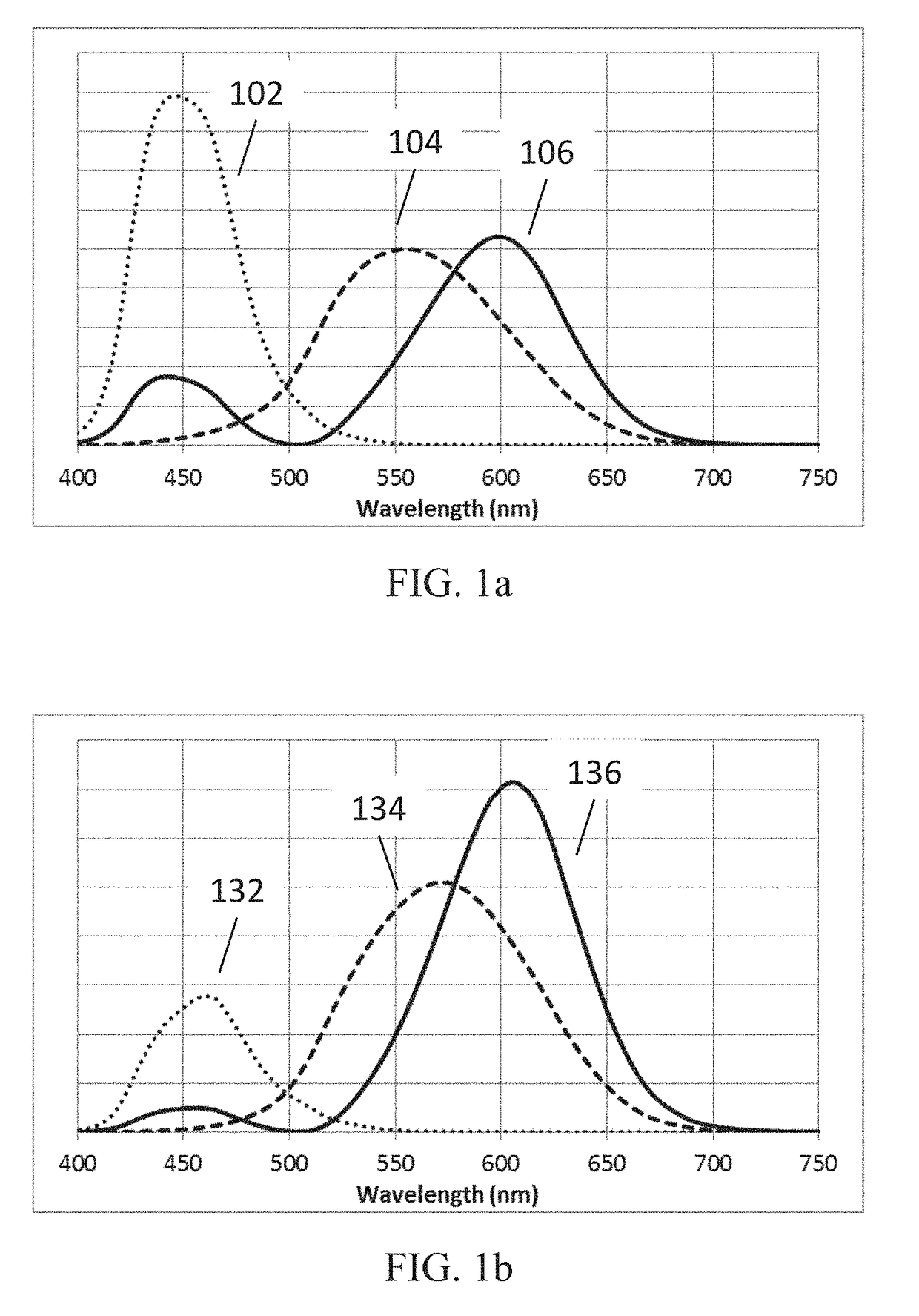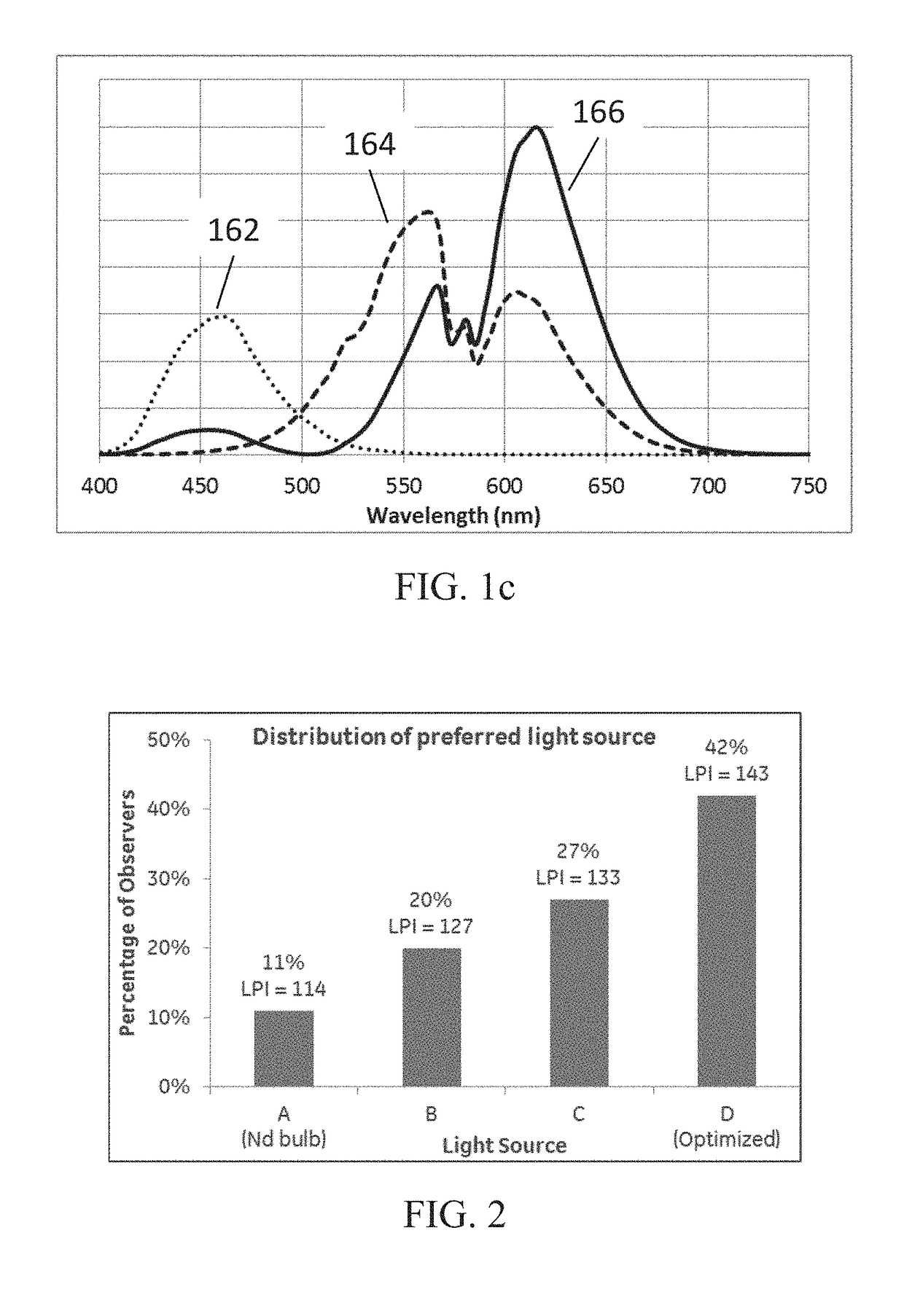Enhanced color-preference LED light sources using lag, nitride, and pfs phosphors
a led light source and color-preference technology, applied in the field of enhanced color-preference led light source using lag, nitride, and pfs phosphors, can solve the problems of insufficient evaluation and reflection of led products by current metrics, insufficient effectiveness of current metrics, and inability to recognize such enhanced lighting products
- Summary
- Abstract
- Description
- Claims
- Application Information
AI Technical Summary
Benefits of technology
Problems solved by technology
Method used
Image
Examples
fourth embodiment
In this fourth embodiment, an LPI of about 143 is obtained, so that a human observer may perceive more saturated colors, enhanced whiteness, and a much more preferred color appearance when utilizing the LAG+Nit spectrum 2900 than is possible by using light sources typically having LPI of 120 or less.
[0164]In a fifth exemplary embodiment of a light source, providing slightly reduced color preference (LPI) for a LAG+Nit light source than the fourth embodiment, the peak and dominant wavelengths of the G or YG LAG phosphor 2904 in FIG. 29 are shifted relative to the optimal peak and dominant wavelengths of 531 nm and 555 nm of the fourth embodiment, and the peak wavelength of the nitride red phosphor 2906 in FIG. 29 is shifted relative to the optimal peak wavelength of 670 nm of the fourth embodiment. In the fifth embodiment, DomLAG may be in the range of about 548 nm to about 566 nm, and PeakNit may be in the range of about 650 to about 680 nm, while Duv of the color point remains near...
sixth embodiment
In this sixth embodiment, an LPI of about 120 or greater is obtained, meaning that a human observer will perceive more saturated colors, enhanced whiteness, and a more preferred color appearance when utilizing the LAG+Nit spectrum 2900 than is possible by using light sources typically having LPI of 120 or less.
seventh embodiment
[0166]In a seventh exemplary embodiment of a light source, providing the highest color preference (LPI) for a LAG+PFS+Nit light source, the LED light source may include one or more groups of LEDs that may each consist of one or more blue LEDs coated with G or YG LAG phosphor and a combination of NR PFS phosphor and BR nitride phosphor (LAG+PFS+Nit), where the portion of the blue light generated by the blue LED that is not absorbed by the phosphor materials, combined with the light emitted by the phosphor materials, may provide light which appears to the human eye as being nearly white in color. The spectrum of a LAG+PFS+Nit light source having enhanced color preference may be composed of a blue LED peak emission in the range of about 400 nm to about 460 nm, a G or YG peak emission in the range of about 505 nm to about 555 nm created by the excitation of a LAG phosphor by the blue emission from the LED, a red peak emission at about 631 nm created by the excitation of a NR PFS phospho...
PUM
| Property | Measurement | Unit |
|---|---|---|
| peak wavelength | aaaaa | aaaaa |
| peak wavelength | aaaaa | aaaaa |
| peak wavelength | aaaaa | aaaaa |
Abstract
Description
Claims
Application Information
 Login to View More
Login to View More - R&D
- Intellectual Property
- Life Sciences
- Materials
- Tech Scout
- Unparalleled Data Quality
- Higher Quality Content
- 60% Fewer Hallucinations
Browse by: Latest US Patents, China's latest patents, Technical Efficacy Thesaurus, Application Domain, Technology Topic, Popular Technical Reports.
© 2025 PatSnap. All rights reserved.Legal|Privacy policy|Modern Slavery Act Transparency Statement|Sitemap|About US| Contact US: help@patsnap.com



